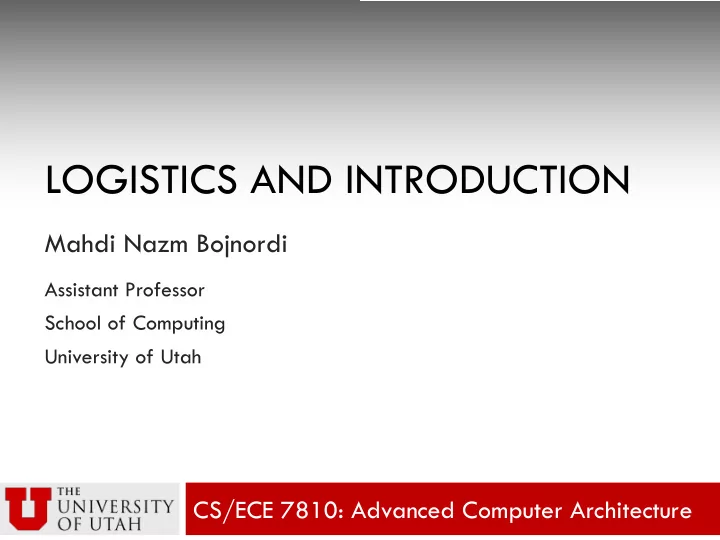

LOGISTICS AND INTRODUCTION Mahdi Nazm Bojnordi Assistant Professor School of Computing University of Utah CS/ECE 7810: Advanced Computer Architecture
Advanced Computer Architecture Basics of Computer Processor/Memory Today/Future Systems: CPU, Performance Concerns: Memory, Storage, IO, Optimization: ILP, Power Wall, etc. TLP, AMAT, etc. Energy-efficiency, Security, etc.
Logistics Course organization and rules
Instructor ¨ Mahdi Nazm Bojnordi ¤ Assistant Professor, School of Computing ¤ PhD degree in Electrical Engineering (2016) ¤ Worked in industry for four years (before PhD) ¨ Research in Computer Architecture ¤ Energy-efficient computing ¤ Emerging memory technologies ¨ Office Hours ¤ Please email me for appointment ¤ MEB 3418
This Course ¨ Prerequisite ¤ CS/ECE 6810: Computer Architecture ¨ Advanced topics in computer architecture ¤ cache energy innovations ¤ memory system optimizations ¤ interconnection networks ¤ cache coherence protocols ¤ emerging computation models
Resources ¨ Recommended books and references ¤ “Memory Systems: Cache, DRAM, Disk”, Jacob et al ¤ “Principles and Practices of Interconnection Networks”, Dally and Towles ¤ “Parallel Computer Architecture”, Culler, Singh, Gupta ¤ “Synthesis Lectures on Computer Architecture”, Morgan & Claypool Publishers ¨ Class webpage ¤ http://www.cs.utah.edu/~bojnordi/classes/7810/s20/
Class Webpage ¨ Please visit online!
Course Expectation ¨ Use Canvas for all of your submissions ¤ No scanned handwritten documents please! ¨ Grading Fraction Notes Project 50% One simulation-based project Homework 20% One homework assignment Paper presentation 10% One in class paper presentation Final 20%
Course Project ¨ A creative, simulation-based project on ¤ Memory system optimization (SRAM, DRAM, RRAM, etc.) ¤ Data movement optimizations (Off/On–chip interfaces) ¤ Hardware accelerators (GPU, FPGA, ASIC) ¤ … ¨ Form a group of 2 people by Feb. 2 ¨ Choose your topic by Feb. 10 ¨ Prepare for an in-class presentation in April ¨ Prepare a conference-style report by end of May
Paper Presentation and Assignment ¨ Every student presents a paper in class ¤ A related work on your course project is recommended ¤ Three main components must be included n The goal and key idea n Strengths and weaknesses n Future work ¤ Email me your paper by Mar. 25 n Conferences such as ISCA, MICRO, ASPLOS, HPCA ¨ A homework assignment will be posted on Feb. 24 ¤ Due on Mar. 4 (11:59PM)
Academic Integrity ¨ Do NOT cheat!! ¤ Disciplinary hearings are no fun ¤ Please read the Policy Statement on Academic Misconduct, carefully. ¤ We have no tolerance for cheating ¨ Also, read the College of Engineering Guidelines for disabilities, add, drop, appeals, etc. ¨ For more information, please refer to the important policies on the class webpage.
About You … ¨ Are you working in a research areas? ¨ Do you know programming languages? ¤ C/C++ ¨ Do you know any hardware description languages? ¤ Verilog ¨ Are you familiar with simulators?
Energy-efficient Computing The importance of energy efficient computing
Energy and Power Trends ¨ Power consumption is increasing significantly (data source: ITRS, DarkSilicon’11) Processor Power Normalized 4.5 4 3.5 3 2.5 to 2010 2 1.5 1 0.5 0 2010 2012 2015 2018 2021 Year
CPU Power Consumption ¨ Major power consumption issues Peak Power/Power Density Average Power q Heat q Battery life o Packaging, cooling, o Bulkier battery q Utility costs component spacing q Switching noise o Probability, cannot run o Decoupling capacitors your business!
New Challenges ¨ Excessive energy consumption ¤ More energy-efficient architectures are needed 200M wearable devices will be sold in 2019 (source: IDC forecast)
New Challenges ¨ Power delivery and cooling systems ¤ More energy-efficient architectures are required Facebook datacenter at edge of the Microsoft underwater datacenter Arctic circle (source: CNET, 2013) (source: NYTimes, 2016)
The High Cost of Data Movement ¨ Data movement is the primary contributor to energy dissipation in nanometer ICs. Processor DRAM Module A Relative A + B Energy Costs 500x 10x 1x B Source: NVidia
Data Movement Energy Increasing ¨ By 2020, the energy cost of moving data across the memory hierarchy will be orders of magnitude higher than the cost of performing a floating point operation. -- U.S. Department of Energy, 2014 1 Compute Energy 0.8 Relative Energy Interconnect Energy 0.6 0.4 0.2 0 90 65 45 32 22 14 10 7 Technology (nm) Shekhar Borkar, Journal of Lightwave Technology, 2013
Possible Solutions ¨ How to minimize data movement energy? Processor DRAM Module
Problem: Energy Efficiency ¨ Unconventional solutions are needed! ¤ Hardware ¤ Software Solar powered dresses Harvesting motion energy (source: www.ecochunk.com) (source: www.ecouterre.com)
Hardware Architecture “ People who are really serious about software should make their own hardware. ” — Alan Kay
Research Examples ¨ Goal: enable energy and bandwidth efficient data movement between memory and the processor cores. 1. Energy efficient Core 1 Core N data encoding for large on-die cache 3. Efficient In- 3D Stacked Last Level Cache Memory Dice Package Memory Systems Controller 2. Bandwidth and Main Memory Energy Efficient 4. Non-von Neumann Interface Computing In Memory Modules with Emerging Technologies
Emerging Technologies ¨ High bandwidth memory Off-chip Memory 3D Stacked Memory Lower Bandwidth Higher Bandwidth Lower Costs Higher Costs
Emerging Non-volatile Memories ¨ Use resistive states to represent info. ¤ Can we build non-von Neumann machines? n In-Memory and In-situ computers
Recommend
More recommend